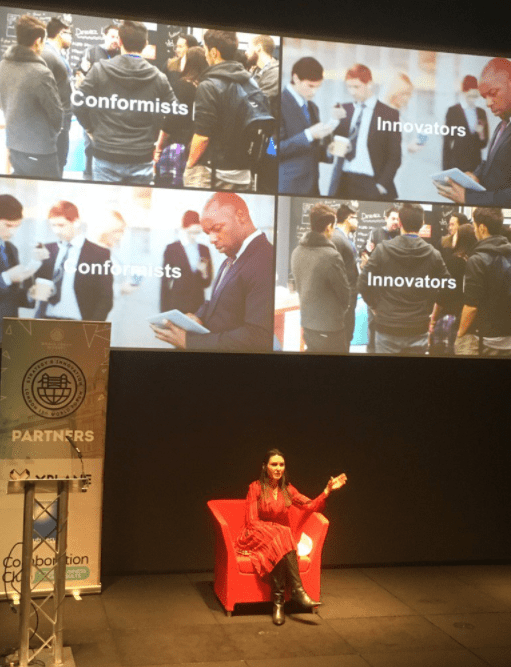Key lessons from the Strategy and Innovation World Forum
Robert Jones, our research analyst and I headed off to London last week to go to the Strategy and Innovation World Forum, set up by World Forum Disrupt. The Innovation Directors were attending in force, and with talks from the global heads of innovation from Santander, BT, UNICEF, Vodaphone and other world leading businesses there were plenty of interesting lessons to be gleaned.
With over 32 different speakers over the two days of the forum, it would be a bit of an information overload, if I tried to convey everything that was discussed at the event. But it did offer some great insights into the cutting edge of innovation strategy, so I've tried to distil the top 8 talks into just a few bite-sized takeaways that you can learn from and implement when developing your own innovation strategy.
Setting Strategies for uncertain times - Bertrand Hassani - Global Head of Innovation - Santander
This was my favorite of all the talks, combining great theoretical knowledge with actionable and practical advice, that's our style at Smart Insights.
Bertrand emphasized the fact that all brands, no matter their size, must be willing to take risks and to fail. Boiling down his key insights, he advises us that:
- You must test fast, fail fast and reiterate. No one gets it right first time.
- You should value of lessons taken from failure as much as you value the lessons taken from success.
- You should utilize data analytics as much as possible, as decisions based on data are far more likely to be right than those which are based on the highest paid person's opinion.
- Larger businesses should create innovation hubs, utilising university campuses or creating small teams based in technology hubs like silicon valley.
How Innovation has become conformity in disguise - Shannon Riley - Director of Strategy and Operations - News UK
I loved this talk because it challenges that self-congratulatory atmosphere of corporate buzzwords that so often develops around strategy and innovation events. Shannon made the point that if you are innovating in the same way as everyone else, you aren't innovating. Innovation is defined by being different. The key lessons she imparted were:
- Don't hop on bandwagons and try to be part of every new trend
- Data is never perfect or complete, you can't always rely on data to make decisions- look how wrong pollsters consistently call elections/referendums!
- Competitive advantage is gained by doing something different from the competition. You can't get this by copying competitors, you have to strike out and do something genuinely novel.
- Successful innovators go against the direction of travel of the rest of the population. If everyone is patting you on the back and saying it's a great idea, it probably isn't actually innovative.

Everyone in your office knows your password - Sam Tatam - Director of Behavioral Strategy
This talk's title is misleading, it wasn't about security, but about behavioral science. Sam started off by making the point that in the name of security many offices force employees to change their password every month. Because most employees can't be doing with the hassle of remembering a new password every month, they just change their password to 'Febuary2017' or whatever the name of the month is. His study found these passwords accounted for about one-quarter of the passwords in the office, meaning a large chunk of the office all had the same password! The irony is this terribly insecure system was brought about by a rule designed to increase security. This teaches us something about how we should be putting humans at the forefront of how we design customer experiences, and how it's critical to properly understand behavioral psychology if you want to build an effective user experience. He gave us five key principles of behavioral science which marketers can use to make their messaging more effective.
- Easy - Make what you want people to do easy. People are like water, the always follow the route of least resistance.
- Attractive - Make what you want people to do stand out. Use bright colors, big buttons etc.
- Social - People like to see other people doing something before they do it themselves. People tend to want to do what is popular. Make it clear that many other people are doing what you want your users to do.
- Time - People often behave on impulse, it's therefore important to be there at the right time. Showing that an offer will soon expire is extreemly effective at getting people to use it.
- Loss Aversion - People are twice as motivated to avoid a loss as they are to achieve a gain.
Digital Disruption and Transformation - Kevin Mansfield - Head of Product and Innovation at the Racing Post.
We talk about digital transformation a lot at SmartInsights, and Kevin provided some great insights from the 'coalface' so to speak, telling us what he'd learned from the process of transforming a very 'traditional' business into one with a digital-first approach. Here are the key lessons Kevin had for those looking to embark on digital transformation:
- Digital Transformation depends on 4 key behaviours: Customer focus, collaboration, leadership, and data-driven decisions.
- Before you start the process of trying to digitally transform, conduct research to understand your customers wants and needs, so you can align the whole process with what the customer wants.
- Establish a multi-disciplinary 'product council' from across the business, responsible for the product strategy. This will break down siols and mean all aspects of the business have an input.
- Use concept discovery to test very simple prototypes with customers to see if they engage with them. – Rapidly prototype over a 5 day process with 3 customer days and 2 iteration days. Customer days test the product and iteration days change how the prototype works
The future of customer engagement - Saul Betmead - Chief Strategy Officer of Young & Rubicam.
Saul's talk focused on branding and how customers see brands in a rapidly changing environment. It turns most brands are seeing their value erode, but a select few tech-super brands like AirBnB, Google etc. are seeing their value soar. The key points he imparted were:
- A brand survey with over 1 million respondents found 66% of brands to be stagnant or in decline.
- Most people wouldn't care if 74% of brands disappeared - it's only a tiny minority of brands that matter.
- Consumer expectations are rising across categories. Consumer's do not base their expectations on your competitors, they base them on digital leaders like Amazon, Netflix etc.
- Testing multiple ideas and back the ones that work is the only way to work when the fast changing climate means it is impossible to know what will be successful and what won't.
- The most successful brands combine being purposeful, inventive and sociable.
Letting the story drive technology - John Vary - Manager of Innovation and John Lewis.
John's pithy and interesting talk didn't mince words and didn't use industry buzzwords. He kept it simple and imparted the following important lessons:
- Use a small team in a skunkworks, and keep it separate from day to day objectives to keep it innovative.
- Design the technology in-house rather than use agencies so you develop your internal expertise.
- Trust each other and don't focus on narrow KPIs.
How natural interfaces will re-define social in 2017 - Tom Ollerton - Director of Innovation at We Are Social
Tom's talk was really interesting because We Are Social are at the cutting edge of some of the latest development we are seeing in the social marketing space. One interesting tidbit to some out of his talk was the fact that 'Dom the Pizza bot', the Bot which orders pizza for you through Facebook Messanger doesn't actually use any AI at all. Although many news outlets picked up on the bot as an example of AI in marketing, it's actually just based on a spreadsheet of set responses their team spent a day putting together! Tom stressed the emerging importance of spoken interfaces like Amazon's Alexa, Apple's Siri, and Google Now. He made the point that:
- Natural spoken interfaces will become the most popular way of interacting with many of our devices because they offer the least friction.
- Because of the rising popularity of spoken interfaces brands will increasingly need to develop digital personalities. Will your brand be funny, sassy, or serious?
The real path to integrated innovation - Grace Letley - Director of Strategy at Vizeum
Grace's talk was about how innovation often comes from unexpected places, and the value of different viewpoints. She made a couple of really valuable points to bear in mind when putting together innovation teams:
- Diversity is valuable for creating different perspectives. Innovation happens when different ideas meet. If everyone agrees with each other there is no point working together.
- Teams should be given permission to not ask for permission. They have to be able to go where their curiosity takes them.
Download Expert Business Level Resource – Marketing technology and media innovation guide 2017
The guide outlines 6 of the most important new technologies marketers should consider when planning for future investment in customer-facing marketing experiences and communications to encourage brand engagement and purchase.
Access the Marketing technology and media innovation guide









